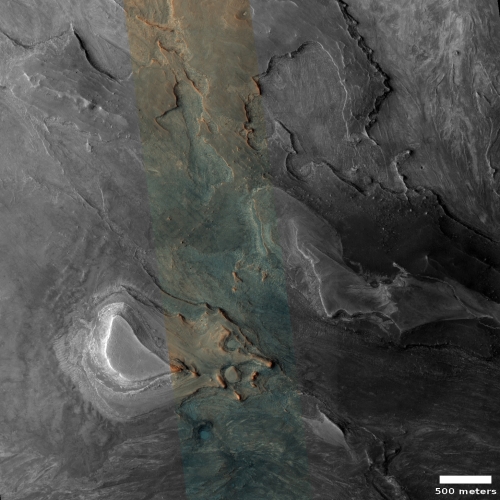On the edge of Mars’ glacier country
Today’s cool image sits right on the southern edge of Mars’ northern glacier country, at 29 degrees north latitude. The picture to the right, cropped and reduced to post here, was taken of this location on June 4, 2021 by the high resolution camera on Mars Reconnaissance Orbiter (MRO). It shows what appears to be the exposed and scraped bedrock and mesas on the floor of an unnamed 60-mile-wide crater.
That scraped bedrock is quite beautiful, reminiscent of the bare carved mesas and bedrock one sees throughout the southwest of the United States. To hike from that central valley to the top of the bright mesa would be a fine experience, especially because of the suggested change in colors in the color strip.
The overview map below gives more context.

Unlike craters only a few hundred miles to the north in Nilosyrtis Mensae, which seem filled with icy glacial material, this crater seems quite dry. Instead, we appear to be looking at the leftover scraped erosion created by now gone glaciers that had flowed downhill to the southeast. The look is also very similar to the floor of another crater just 100 miles to the south that I highlighted only a few weeks ago.
The images from this region strengthen the conclusions of Mars researchers that the mid-latitude glacial band in the northern hemisphere of Mars does not extend past 30 degrees latitude. North of that line images show ample evidence of glaciers. South of that line the evidence of glacial material disappears. A similar circumstance likely exists in the southern hemisphere, though its generally higher elevation will change things somewhat.
On Christmas Eve 1968 three Americans became the first humans to visit another world. What they did to celebrate was unexpected and profound, and will be remembered throughout all human history. Genesis: the Story of Apollo 8, Robert Zimmerman's classic history of humanity's first journey to another world, tells that story, and it is now available as both an ebook and an audiobook, both with a foreword by Valerie Anders and a new introduction by Robert Zimmerman.
The print edition can be purchased at Amazon or from any other book seller. If you want an autographed copy the price is $60 for the hardback and $45 for the paperback, plus $8 shipping for each. Go here for purchasing details. The ebook is available everywhere for $5.99 (before discount) at amazon, or direct from my ebook publisher, ebookit. If you buy it from ebookit you don't support the big tech companies and the author gets a bigger cut much sooner.
The audiobook is also available at all these vendors, and is also free with a 30-day trial membership to Audible.
"Not simply about one mission, [Genesis] is also the history of America's quest for the moon... Zimmerman has done a masterful job of tying disparate events together into a solid account of one of America's greatest human triumphs."--San Antonio Express-News
Today’s cool image sits right on the southern edge of Mars’ northern glacier country, at 29 degrees north latitude. The picture to the right, cropped and reduced to post here, was taken of this location on June 4, 2021 by the high resolution camera on Mars Reconnaissance Orbiter (MRO). It shows what appears to be the exposed and scraped bedrock and mesas on the floor of an unnamed 60-mile-wide crater.
That scraped bedrock is quite beautiful, reminiscent of the bare carved mesas and bedrock one sees throughout the southwest of the United States. To hike from that central valley to the top of the bright mesa would be a fine experience, especially because of the suggested change in colors in the color strip.
The overview map below gives more context.

Unlike craters only a few hundred miles to the north in Nilosyrtis Mensae, which seem filled with icy glacial material, this crater seems quite dry. Instead, we appear to be looking at the leftover scraped erosion created by now gone glaciers that had flowed downhill to the southeast. The look is also very similar to the floor of another crater just 100 miles to the south that I highlighted only a few weeks ago.
The images from this region strengthen the conclusions of Mars researchers that the mid-latitude glacial band in the northern hemisphere of Mars does not extend past 30 degrees latitude. North of that line images show ample evidence of glaciers. South of that line the evidence of glacial material disappears. A similar circumstance likely exists in the southern hemisphere, though its generally higher elevation will change things somewhat.
On Christmas Eve 1968 three Americans became the first humans to visit another world. What they did to celebrate was unexpected and profound, and will be remembered throughout all human history. Genesis: the Story of Apollo 8, Robert Zimmerman's classic history of humanity's first journey to another world, tells that story, and it is now available as both an ebook and an audiobook, both with a foreword by Valerie Anders and a new introduction by Robert Zimmerman.
The print edition can be purchased at Amazon or from any other book seller. If you want an autographed copy the price is $60 for the hardback and $45 for the paperback, plus $8 shipping for each. Go here for purchasing details. The ebook is available everywhere for $5.99 (before discount) at amazon, or direct from my ebook publisher, ebookit. If you buy it from ebookit you don't support the big tech companies and the author gets a bigger cut much sooner.
The audiobook is also available at all these vendors, and is also free with a 30-day trial membership to Audible.
"Not simply about one mission, [Genesis] is also the history of America's quest for the moon... Zimmerman has done a masterful job of tying disparate events together into a solid account of one of America's greatest human triumphs."--San Antonio Express-News


